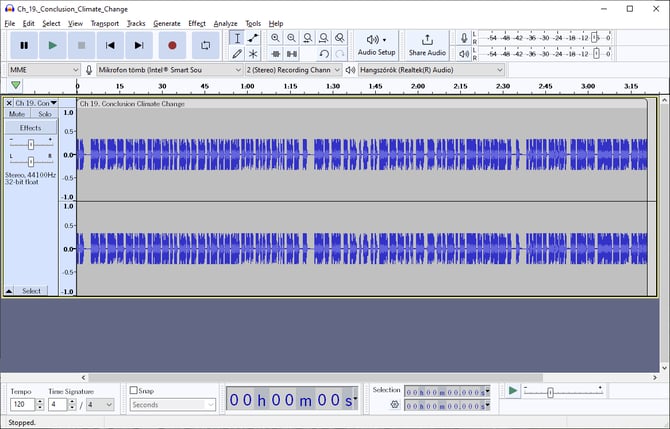How to Correct Audio Files in Audacity to Match Specific Parameters
Audacity is an excellent tool for this task. This guide walks you through the process step by step.
If you need to adjust audio files to meet the following specifications:
• 192kbps CBR stereo MP3
• Overall Peak Level ≤ -3.0 dB
• Overall RMS Level between -23.0 dB and -18.0 dB,
Step 1: Prepare Your File in Audacity
-
Open Audacity: Download and install Audacity if you haven’t already (Audacity Download Page).
-
Import Your Audio File:
-
Go to File > Import > Audio or simply drag and drop your file into the Audacity window.
-
-
Ensure Stereo Format:
-
Check the track header on the left side. If it says “Mono,” convert the track to stereo by going to Tracks > Mix > Mix and Render to New Track. ( if you can see one sound wave the file is Mono, if two, the file is Stereo)
-
Mono:

Stereo:

Step 2: Adjust Peak Levels
To ensure the overall peak level is ≤ -3.0 dB:
-
Select the Entire Track:
-
Use Ctrl+A (Windows) or Command+A (Mac).
-
-
Open the Amplify Tool:
-
Navigate to Effect >Volume and Compression > Amplify.
-
-
Set Peak to -3.0 dB:
-
In the dialogue box, look at the “New Peak Amplitude” field. Set it to -3.0 dB.
-
Audacity will automatically calculate the necessary amplification.
-
If the audio peaks above -3.0 dB, this adjustment will reduce the levels. Click OK to apply the change.
-

Step 3: Adjust RMS Levels
To meet the requirement of RMS levels between -23.0 dB and -18.0 dB:
-
Install the Loudness Normalization Plugin (if needed):
-
Audacity comes with the Loudness Normalization tool. If it’s missing, download and install the Nyquist plugins from the Audacity website.
-
-
Apply Loudness Normalization:
-
Go to Effect > Volume and Compression > Loudness Normalization.
-
Select RMS as the normalization method.
-
Set the Target RMS Level to a value within the specified range, e.g., -20.0 dB (a midpoint between -23.0 dB and -18.0 dB).
-
Click OK to apply the effect.
-
-
Verify RMS Levels:
-
Use the Measure RMS tool or a plugin like ReplayGain to confirm the adjusted RMS level.
-

Step 4: Export as 192kbps CBR Stereo MP3
-
Open Export Settings:
-
Go to File > Export as Audio
-
-
Configure MP3 Settings:
-
In the Export dialog box:
-
Set the Bit Rate Mode to Constant.
-
Set the Quality to 192 kbps.
-
Ensure the Channel Mode is set to Stereo.
-
-
-
Save the File:
-
Choose a location and click Save.
-

Step 5: Final Quality Check
-
Confirm Peak Levels:
-
Use View > Show Clipping in Waweform to ensure no parts of the audio exceed the -3.0 dB threshold.
-
-
Double-Check RMS Levels:
-
Use an external tool like Audacity’s ReplayGain to verify RMS levels are within the specified range.
-
Tips for Best Results
-
Avoid Excessive Compression: Over-compression to adjust RMS levels can reduce audio quality. Apply adjustments incrementally.
-
Check for Clipping: Always monitor for clipping after applying effects.
-
Backup Original Files: Save a copy of your unedited audio file before making changes.
By following these steps, you’ll ensure your audio files meet the required parameters and maintain optimal quality.